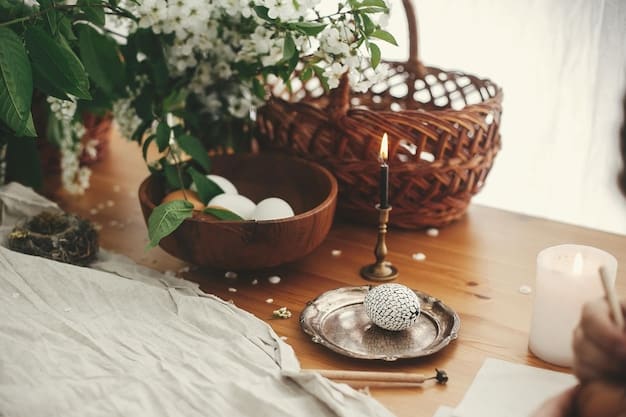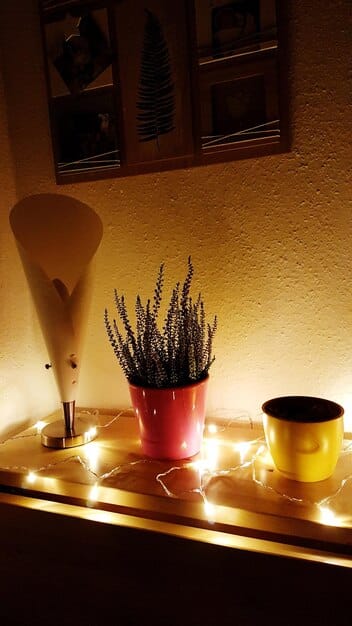Creating Your Sacred Space: Altar and Ritual Guide

Creating your sacred space involves setting up an altar and ritual area that resonates with your personal spiritual practices, providing a dedicated environment for focus, meditation, and connection with the divine or the energies you wish to invoke, enhancing your spiritual journey.
Embark on a transformative journey by creating your sacred space, a sanctuary designed to deepen your spiritual practice. This guide will help you set up an altar and ritual area that resonates with your personal energy and intentions, fostering a powerful connection to the divine.
Understanding the Essence of a Sacred Space
A sacred space is more than just a physical location; it is a personal sanctuary where you can connect with your inner self, the divine, or the energies of the universe. Understanding its essence is crucial before you begin to create one.
It serves as a focal point for your spiritual practices, providing a dedicated environment free from distractions and imbued with your intentions. It’s a place where you can meditate, perform rituals, and reflect on your spiritual journey.
The Psychological Impact of a Sacred Space
Creating a sacred space can have a profound psychological impact. It can help to reduce stress, increase mindfulness, and promote a sense of peace and well-being.
- 🧠 By having a designated area for spiritual practice, you train your mind to associate that space with tranquility and focus.
- ✨ The act of creating the space itself can be a meditative and grounding experience.
- 🧘♀️ Regular use of the space reinforces these positive associations, making it easier to enter a state of mindfulness or meditation.
Your sacred space becomes a physical manifestation of your spiritual intentions, reinforcing your commitment to your practice and providing a tangible connection to the divine.
Choosing the Right Location
Selecting the right location is a foundational step in creating your sacred space. The location should be conducive to peace, reflection, and spiritual connection.
Consider factors like privacy, natural light, and the overall energy of the space. A quiet corner of a room, a secluded garden spot, or even a small shelf can be transformed into a powerful sacred space.

Indoor vs. Outdoor Spaces
The choice between an indoor and outdoor space depends on your personal preferences and the nature of your practice. Both offer unique benefits and challenges.
Indoor spaces offer privacy and protection from the elements, while outdoor spaces provide a direct connection to nature.
- 🏠 Indoor spaces allow for greater control over the environment, making it easier to create a consistent atmosphere.
- 🌳 Outdoor spaces can be incredibly grounding and provide a connection to the earth’s energies.
- ☀️ Consider the climate and seasonal changes when choosing an outdoor space.
Cleansing and Preparing the Area
Before setting up your sacred space, it is important to cleanse and prepare the area. This helps to remove any negative energies and create a fresh, clean slate.
Smudging with sage, incense, or using sound vibrations can be effective ways to cleanse a space. You can also use visualization techniques or simply set the intention for a clean and positive environment.
Selecting Objects for Your Altar
Choosing the right objects for your altar is a deeply personal process. Each item should resonate with your intentions and reflect your spiritual beliefs.
Common altar objects include candles, crystals, statues, incense, and representations of the elements. The key is to select items that hold meaning for you and enhance your connection to the divine.
The Significance of Candles
Candles are a staple on many altars, representing light, warmth, and the presence of spirit. The color of the candle can also carry specific meanings.
White candles represent purity and clarity, while other colors can be used to invoke specific energies or intentions. For example, green candles are often used for healing and abundance, while purple candles are associated with intuition and spiritual growth.
- 🔥 Use candles made from natural wax, such as beeswax or soy wax, for a cleaner burn and to avoid harmful chemicals.
- 🕯️ Always practice candle safety and never leave a burning candle unattended.
- 🌟 Consider using candle holders that are both functional and aesthetically pleasing.
The flickering flame of a candle can serve as a focal point for meditation and can help to create a calming and peaceful atmosphere.
Choosing Crystals and Stones
Crystals and stones are powerful tools for amplifying energy and intention. Each crystal has unique properties and can be used to support different aspects of your spiritual practice.
- 💎 Amethyst is known for its calming and spiritual properties, making it a great choice for meditation.
- 🔮 Rose quartz is associated with love and compassion, promoting emotional healing and self-love.
- 🌟 Clear quartz is a versatile crystal that can amplify the energy of other stones and intentions.
When selecting crystals, trust your intuition and choose the ones that you feel drawn to. Cleanse your crystals regularly by placing them in sunlight or moonlight, or by using water or sound vibrations.
Arranging Your Altar
The arrangement of your altar is an important aspect of creating your sacred space. Consider the principles of balance, harmony, and personal symbolism when arranging your objects.
There is no right or wrong way to arrange an altar, but a well-organized and aesthetically pleasing altar can help to focus your mind and enhance your spiritual connection.
Working with the Elements
Many traditions incorporate the four elements of earth, air, fire, and water on the altar. This can be done through symbolic representations or physical objects.
Earth can be represented by crystals, stones, or soil. Air can be represented by incense or feathers. Fire can be represented by candles. Water can be represented by a bowl of water or seashells.
- 🌿 Incorporating the elements can help to balance the energies of your sacred space.
- 💨 The placement of the elements can also be symbolic; for example, earth is often placed in the north, air in the east, fire in the south, and water in the west.
- 💧 Consider the symbolism and energies of each element when arranging your altar.
Personalizing Your Space
Ultimately, your altar should reflect your personal beliefs and spiritual path. Don’t be afraid to incorporate unique objects and symbols that hold special meaning for you.
Photos of loved ones, personal talismans, or objects found in nature can all be powerful additions to your sacred space. The key is to create a space that feels authentic and resonates with your energy.

Incorporating Rituals and Practices
Once your altar is set up, it’s time to incorporate rituals and practices into your sacred space. This is where the real magic happens.
Whether you prefer meditation, prayer, spellwork, or simply spending time in quiet reflection, your sacred space can serve as a powerful catalyst for your spiritual growth.
Daily Meditation
Daily meditation is a powerful practice that can help to calm the mind, reduce stress, and deepen your spiritual connection. Your sacred space can provide a dedicated environment for this practice.
- 🧘♀️ Sit comfortably in front of your altar, focus on your breath, and allow your thoughts to pass without judgment.
- ✨ You can also use guided meditations or focus on a specific intention or affirmation.
- 🌟 Even just a few minutes of daily meditation can have a profound impact on your well-being.
Regular meditation in your sacred space can help to reinforce the positive associations and create a sense of peace and tranquility.
Creating Your Own Rituals
Don’t be afraid to create your own rituals that resonate with your personal beliefs and intentions. Rituals can be as simple or as elaborate as you like.
Lighting a candle, reciting an affirmation, or connecting with the elements are all simple rituals that can be incorporated into your daily practice. The key is to approach your rituals with intention and respect.
Maintaining and Evolving Your Sacred Space
Your sacred space is a living, breathing entity that should evolve along with your spiritual journey. Regular maintenance and updates are essential to keep the space vibrant and effective.
Dust your altar, replace candles, and rearrange your objects as needed. Consider adding new items that resonate with your current intentions and removing items that no longer serve you.
Regular Cleansing
Regular cleansing is essential to keep your sacred space free from negative energies. Smudging with sage, incense, or using sound vibrations can be effective ways to cleanse the space.
- 💨 You can also visualize the space being filled with white light, or simply set the intention for a clean and positive environment.
- 🌿 Pay attention to how the space feels and cleanse it whenever you sense stagnant or negative energy.
- 🌟 Regular cleansing can help to keep your sacred space feeling fresh and vibrant.
By actively participating in the creation, upkeep, and evolution of your altar and ritual space, you’re engaging in an ongoing dialogue with yourself and the spiritual forces you seek to connect with. This dynamic interaction is key to maintaining a powerful and relevant sacred space.
Creating a sacred space is an ongoing process of refinement and personalization. As you evolve, your sacred space should reflect your growth, serving as a constant source of inspiration and connection.
| Key Element | Brief Description |
|---|---|
| 🧘♀️ Intention Setting | Establish clear intentions before creating your space for focused energy. |
| 🌿 Elemental Representation | Incorporate Earth, Air, Fire, Water to balance energies. |
| 💎 Crystal Selection | Choose crystals based on their properties and your personal resonance. |
| 🕯️ Regular Cleansing | Cleanse your space regularly to maintain positive energies. |
FAQ
▼
A space becomes sacred through intention and consistent use for spiritual practices. It’s the energy and focus you bring that transforms it, not the space itself.
▼
Yes, a sacred space can be temporary. You might create one while traveling or outdoors. It’s about creating a mindful space for your practice, however brief.
▼
Cleanse as often as needed. If you sense stagnant energy, after heavy use, or at least monthly will keep the energy fresh and supportive.
▼
Use a small, portable altar. A shelf, windowsill, or even a box can serve. The intention is more critical than the size.
▼
Revise your space! Keep and add items that align with your evolving beliefs, and remove what no longer resonates. Your sacred space should reflect your present self.
Conclusion
Creating your sacred space is a deeply personal and transformative journey. By understanding the essence of a sacred space, choosing the right location, selecting meaningful objects, and incorporating rituals and practices, you can create a powerful sanctuary that supports your spiritual growth and well-being. Regularly maintain and evolve your space to keep it vibrant and relevant to your evolving needs.





